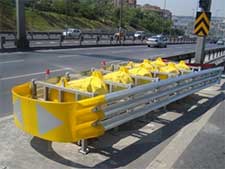The National Cooperative Highway Research Program (NCHRP) recently accepted three proposals as part of a national search for ideas to improve highway safety, including one from UAB mechanical engineering professor Dean Sicking, Ph.D.
Designing a Smarter Crash Cushion
Bringing order to something as chaotic as a car crash is no small feat, but Sicking is no newcomer to highway safety innovation. He gained recognition in recent years as the inventor of the SAFER barrier that is now used on auto racing tracks around the world. Before that, he revolutionized highway safety by inventing guardrail terminals that were installed along interstates across the nation.
 Crash cushions have proven effective in saving drivers, but current designs require costly and sometimes dangerous repairs. Kevin Schrum, Ph.D., a research engineer in the Mechanical Engineering Department, authored the IDEA proposal based on his own experience in conducting cost-benefit analyses on crash cushions. Sicking and Schrum recognized a growing need in the market for a high-performance crash cushion capable of conducting its own maintenance. They received an IDEA award worth $100,000 to design this high-tech crash cushion—improving on a product Sicking designed as a graduate student in the 1980s.
Crash cushions have proven effective in saving drivers, but current designs require costly and sometimes dangerous repairs. Kevin Schrum, Ph.D., a research engineer in the Mechanical Engineering Department, authored the IDEA proposal based on his own experience in conducting cost-benefit analyses on crash cushions. Sicking and Schrum recognized a growing need in the market for a high-performance crash cushion capable of conducting its own maintenance. They received an IDEA award worth $100,000 to design this high-tech crash cushion—improving on a product Sicking designed as a graduate student in the 1980s.
“Crash cushions are the devices you see on interstate exit ramps and other places where two lanes of traffic diverge around a solid barrier,” Sicking explained. “They are designed to absorb the energy of a crash, so when a vehicle strikes the barrier, the individual components collapse and are destroyed.”
The devices work well for crashes, Sicking says, but it often takes days or even weeks to rebuild and install the devices after an accident—a process that costs thousands of dollars and considerable risk to workers who have to stop traffic to perform the repair. Meanwhile, the dangerous barrier sits unprotected.
Under Sicking’s new plan, crash cushions will be made of stronger non-sacrificial parts. The cushion will still collapse to absorb the energy of the crash, but the parts will not be destroyed. In addition, the cushion will be equipped with sensors to measure the impact speed and angle of the crash—data that will be immediately available to highway officials and other authorities. This information can be transmitted instantly when a crash occurs, so there is no need to visit the scene to know what happened.
Equally important, Sicking says, is that the device can be redeployed remotely, reducing the risk of a second crash occurring before the cushion can be reinstalled. “The cushion will be mechanized so that, once the wreck is cleared, the unit can be reset and the cushion will return to its original shape,” he said. “By doing this remotely at the flip of a switch, there is no reason to block traffic or send a repair crew to the scene.”